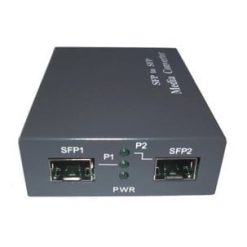What is a Fiber Optic Media Converter?
A fiber optic media converter is a straightforward networking device which is utilized to create a connection in-between two dissimilar media types such as twisted pair with fiber optic cabling. These devices were developed and acquainted with the market around 1997 and the implications of the fiber optic media converters make the networks diverse. The versatility of a fiber optic media converter lies within its ability to interconnect fiber optic cabling-based systems with the existing copper-based, structured cabling systems like the CAT5 and CAT6 LAN networks. A generic media converter comprises of two transceivers that have the capability to transmit data to and receive data from each other, and a power supply Each of the transceivers has different connectors that are compatible with different media. One of the media goes in and the other variety of media comes out. In our case this utility can be used to create a communication between a copper switch that does not have optic fiber connections to the one that does have.
Applications of a Fiber Optic Media Converter
A fiber optic media converter is flexible and can be utilized in any field or scenario from industrial workstations to computers. These fiber optic media converters make the configuration of computer network very versatile. They enable you to upgrade to a more superior and potentially powerful technology without the requirement of a full network retrofit. The primary application of a fiber optic media converter is to extend the network farther. Fiber optic media converters integrate the fiber optic technology that supports a much larger cable than that of the custom twisted pair copper cables. The 10M and 100M copper cables have a range length limitation of 110 meters. This length limitation, after the setup is reduced to 90 meters in the case of CAT5e cables which is still permissible by industrial standards. In contrast, the fiber optic cable has a length limit of 2000 meters. Furthermore, different types of optical fibers showcase differential length limit. For example the single mode fibers support up to 3000 meters. The most usual application of media converters is in the case of twisted pair copper cable networks to fiber optic cables. The standard fiber connectors on these media converters are commonly ST or SC connectors. Here are their applications:
10-Mbps twisted-pair to 10-Mbps fiber optic single mode or Multimode. This setup is often termed as 10BastT to 10BaseFL
100-Mbps twisted-pair to 1000-Mbps fiber optic single mode or Multimode. This setup is usually termed as 100BaseTX to 100BaseFX
The Neccesity of a Fiber Optic Media Converter
The reasons as to why you would want to backup your copper cable structured network with a fiber optic cable are described below:
A fiber optics system is similar to the copper based system with the fact that the fiber optics is replacing the copper based structure.
The difference is that the fiber optics utilizes light pulses to generate a downstream signal through the fiber instead of the traditional electronic impulses used in the case of copper wires. To put it in simple words, the differential refractive indices of the two layers of the fiber optic make it possible for the signal to be transmitted over long distances without surging question of high attenuation. These advantages and various others will be discussed in detail below.
There are several advantages that have been established with the development and implementation of fiber-optic cable systems.
Optical fibers are smaller in size and lightweight than your average copper cable. This character has improvised its functionality and preference to duct space wiring and intra floor conduits.
An optical fiber has the special property of electromagnetic nullification. As discussed above, optical fibers use light as the vector of transmission. This implies that it is immune to any kind of electromagnetic interference like voltage peaks or radio frequency. This is an important consideration while laying cables near industrial hardware or computer equipments.
The photo transmission imbibes optical fibers with the precautionary measure of a fire hazard. As opposed to electrical transmissions, photo transmission can never be a fire threat to an infrastructure.
The most qualitative advantage of an optical fiber is probably the low levels of attenuation. Advancements in optical fiber transmission have made it possible to minimize this factor by a large degree. When an electric pulse travels down the cable length, it slowly loses the signal strength with which it started at the point of transmission. To keep the signal hale and hearty, it has to be boosted at various stages down the line. This is to ensure that the signal is not lost by the time it reaches the receiving end. Fiber optic cables need a less number of these boosting devices than the copper cables in turn which decreases cost.
Experts believe that optical fibers host the potential to offer a large bandwidth. Bandwidth is the ability of a cable to carry information. More the bandwidth of the cable in question, nor is the information it can carry in a given time and space. The largest bandwidth noted till date is 2.5 gigabytes per second. Researchers predict that optical fibers can platter larger bandwidths than these once the separation of light frequencies becomes available.
Summary
Fiber optics has become the basis for telecommunication transmission even in the third world countries. The importance of such an innovation is noteworthy and of premier importance to a network operator or industrialist. Fiber optics media composes immense potential and thus is the new language of transmission. For this very reason, enabling the pre-existing CAT5 and CAT6 LAN networks with a fiber optic media converter is unquestionable. The new world of telecommunication is dawning and the fiber optic media converter is acting as the harbinger.































